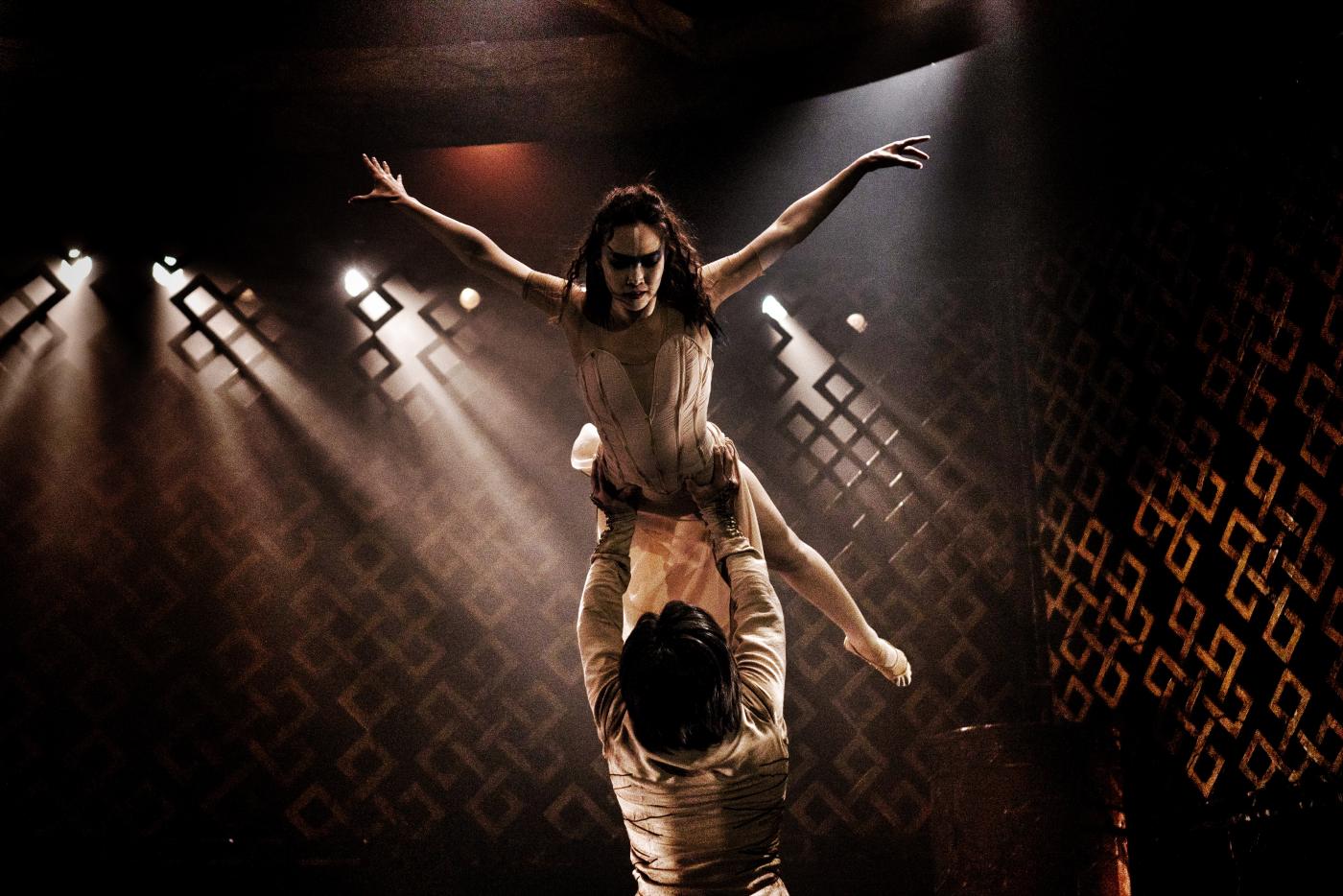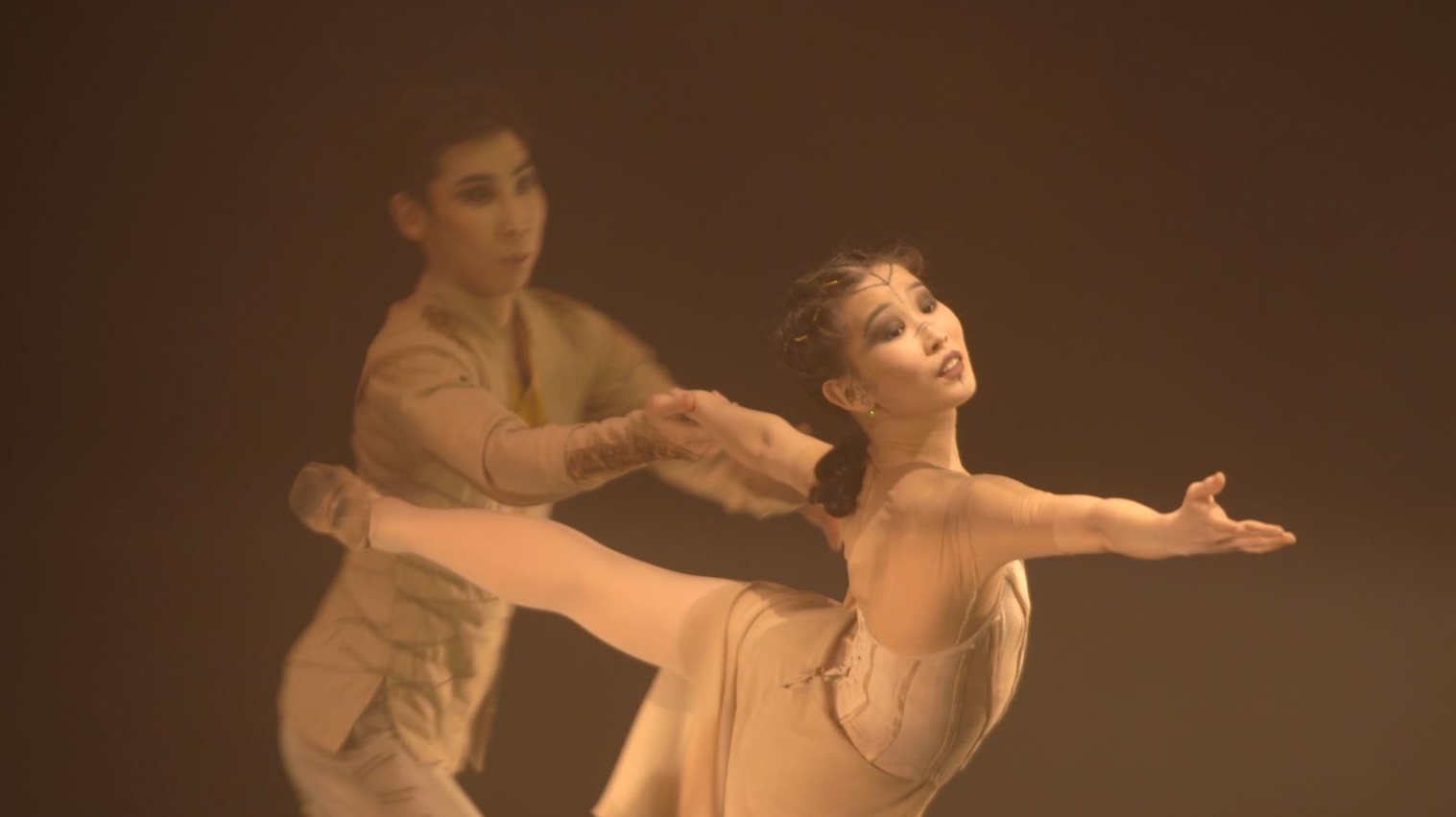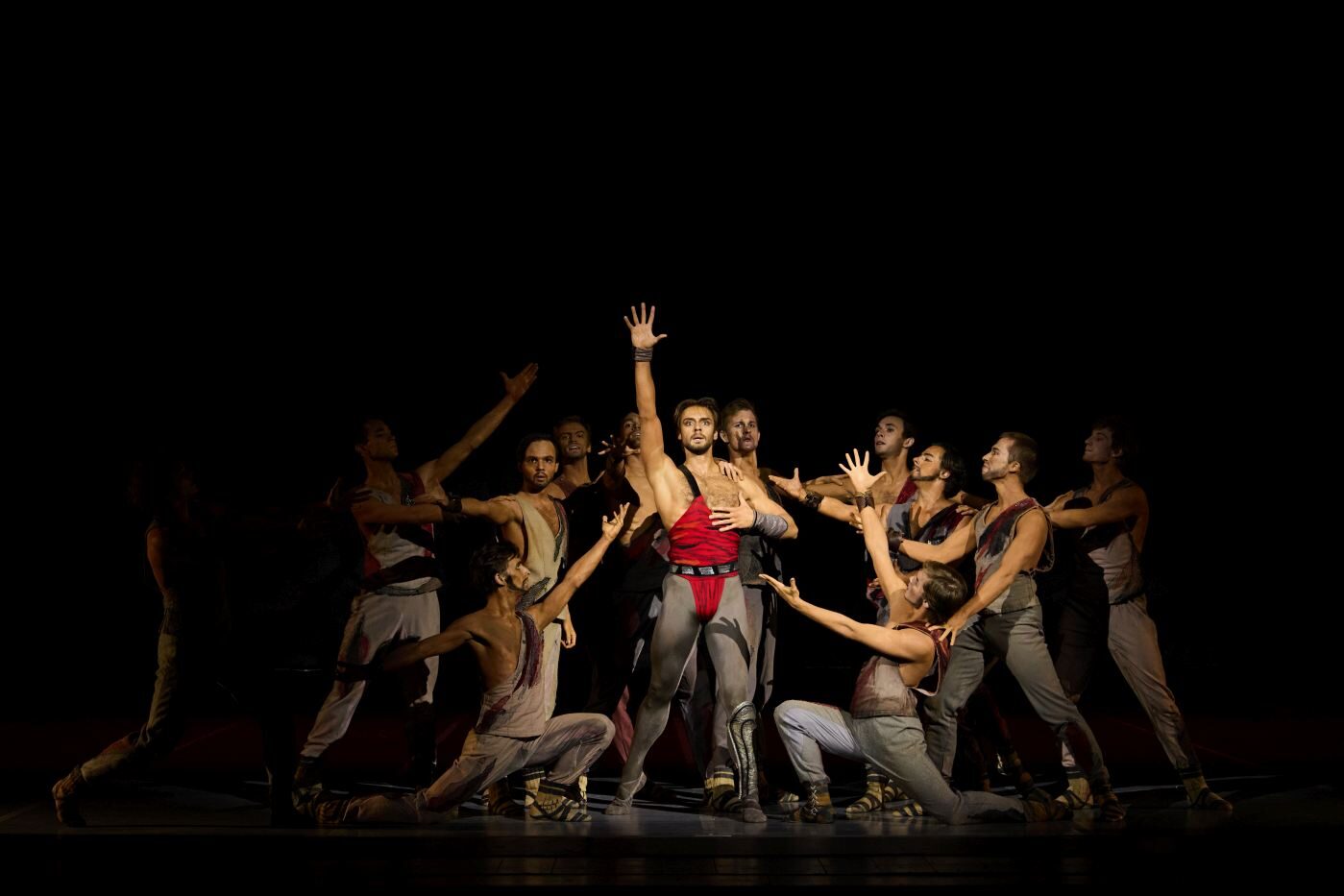“Land of Faith – Bargujin Tukum”
Ballet of the Buryat Academic Ballet and Opera Theatre
Buryat Academic Ballet and Opera Theatre
Ulan-Ude, Russia
February 2024 (video)
by Ilona Landgraf
Copyright © 2024 by Ilona Landgraf
 Roughly 4000 miles separate Moscow from the Sakhalin Island in Russia’s Far East. Two-thirds along this stretch towards the east lies Ulan-Ude, the capital city of the Republic of Buryatia. Its population amounted to 436,000 last year. Lake Baikal is about 100 miles north of Ulan-Ude; the border with Mongolia to the south is 130 miles or so away.
Roughly 4000 miles separate Moscow from the Sakhalin Island in Russia’s Far East. Two-thirds along this stretch towards the east lies Ulan-Ude, the capital city of the Republic of Buryatia. Its population amounted to 436,000 last year. Lake Baikal is about 100 miles north of Ulan-Ude; the border with Mongolia to the south is 130 miles or so away.
Last year, the Republic celebrated the centenary of the foundation of the Buryat Autonomous Soviet Socialist Republic—currently known as Buryatia (which is still an autonomous republic within the Russian Federation). On this occasion, the Buryat National Ballet and Opera Theatre commissioned the Moscow-based contemporary choreographer, Nikita Dmitrievsky, to create a new ballet. His Land of Faith – Bargujin Tukum premiered last May and will return to the schedule later this year. During a tour to Moscow last December, it was shown at the Stanislavsky Theatre. I was able to watch a video of the premiere.

 Land of Faith – Bargujin Tukum is Dmitrievsky’s third ballet dealing with spirituality. The first one, Sansara (2009) for the Ballet Moscow, received the blessing of Thaye Dorje, His Holiness the 17th Gyalwa Karmapa, leader of the Karma Kagyu lineage of Tibetan Buddhism. In Alem (2014), for the Astana Ballet in Kazakhstan, Dmitrievsky described the passage of a soul from heaven to earthly life when being born. Land of Faith – Bargujin Tukum is about the souls of two lovers, Tumen and Asuikhan, who are connected by karma. Their path through different dimensions leads deep into the religious history of Bargujin Tukum (meaning “the land’s end,” a name that 13th-14th century Mongol people gave to the area east of Lake Baikal).
Land of Faith – Bargujin Tukum is Dmitrievsky’s third ballet dealing with spirituality. The first one, Sansara (2009) for the Ballet Moscow, received the blessing of Thaye Dorje, His Holiness the 17th Gyalwa Karmapa, leader of the Karma Kagyu lineage of Tibetan Buddhism. In Alem (2014), for the Astana Ballet in Kazakhstan, Dmitrievsky described the passage of a soul from heaven to earthly life when being born. Land of Faith – Bargujin Tukum is about the souls of two lovers, Tumen and Asuikhan, who are connected by karma. Their path through different dimensions leads deep into the religious history of Bargujin Tukum (meaning “the land’s end,” a name that 13th-14th century Mongol people gave to the area east of Lake Baikal).

 Gennady Bashkuev’s libretto outlines the Buryats’ main religions—the traditionally practiced shamanism and Tibetan Buddhism that became predominant in the early 18th century. The story begins at a shaman power place made of huge stones that are spanned by an arch of mystic blue light. The haggard man resting there seems unperturbed by the howling wind. A fringy hood and a scarf hide his face, and only later will it turn out that he’s the young man Tumen (Eldar Vandanov).
Gennady Bashkuev’s libretto outlines the Buryats’ main religions—the traditionally practiced shamanism and Tibetan Buddhism that became predominant in the early 18th century. The story begins at a shaman power place made of huge stones that are spanned by an arch of mystic blue light. The haggard man resting there seems unperturbed by the howling wind. A fringy hood and a scarf hide his face, and only later will it turn out that he’s the young man Tumen (Eldar Vandanov).

 Soon after, a domed citadel was built on the sacred site. It attracted dark-clad beings whose heavy steps tread in ritually required patterns as well as ghostly creatures whose spike-covered shoulders and long clutches indicated danger (costumes by Tatiana Tyshkenova). A procession of them tried to ascend to the holy area but invariably fell. As the ritual proceeded, three dancers in cages were carried on stage. They represented souls who hadn’t been released into a human body yet. Two of them—a man and a woman—were discaged and confronted one another like gladiators. Masks initially prevented them from identification, yet as soon as the masks came off, the two fighters—Tumen and Asuikhan (Alexandra Bogdanova)—stared at each other in amazement. Deeply affected by the encounter, they ran off just as the ritual approached its climax. The third soul (personified by a blonde woman) wasn’t set free and was sacrificed. First lifted by the crowd like a tall candle, she then quickly sank into the black bunch of huddled bodies as if being devoured by darkness.
Soon after, a domed citadel was built on the sacred site. It attracted dark-clad beings whose heavy steps tread in ritually required patterns as well as ghostly creatures whose spike-covered shoulders and long clutches indicated danger (costumes by Tatiana Tyshkenova). A procession of them tried to ascend to the holy area but invariably fell. As the ritual proceeded, three dancers in cages were carried on stage. They represented souls who hadn’t been released into a human body yet. Two of them—a man and a woman—were discaged and confronted one another like gladiators. Masks initially prevented them from identification, yet as soon as the masks came off, the two fighters—Tumen and Asuikhan (Alexandra Bogdanova)—stared at each other in amazement. Deeply affected by the encounter, they ran off just as the ritual approached its climax. The third soul (personified by a blonde woman) wasn’t set free and was sacrificed. First lifted by the crowd like a tall candle, she then quickly sank into the black bunch of huddled bodies as if being devoured by darkness.

 When Asuikhan returned she was a princess, unrecognizable beneath the dark veil of her wedding dress. We didn’t know that the arrow she handed to a subordinate would later guide Tumen to rescue her from this forced marriage. Despite Asuikhan’s sadness, her maids carried out the marriage ritual, interweaving her long black pigtails and dancing buoyantly. But the singsong had a sad overtone (music by Anastasia Druzhinina), and Asuikhan sat motionless like a stone statue on her throne in the rear. In front of her, an array of celebratory dances unfolded. Godohon fighters showed off their martial arts skills using only their feet (and the special features of their godohon boots) while their hands stayed glued to their backs. Slowly, blood-red-beaked birds mingled with them, and though the men sensed their presence, they couldn’t discern them. The jerkily moving birds (who were young women in disguise) exerted a paralyzing power over the men, turning them into helpless victims who writhed on the floor like worms. One man was almost torn to pieces by their sharp pecking. Amid the turmoil, Tumen returned in the guise of the limping man we met at the beginning.
When Asuikhan returned she was a princess, unrecognizable beneath the dark veil of her wedding dress. We didn’t know that the arrow she handed to a subordinate would later guide Tumen to rescue her from this forced marriage. Despite Asuikhan’s sadness, her maids carried out the marriage ritual, interweaving her long black pigtails and dancing buoyantly. But the singsong had a sad overtone (music by Anastasia Druzhinina), and Asuikhan sat motionless like a stone statue on her throne in the rear. In front of her, an array of celebratory dances unfolded. Godohon fighters showed off their martial arts skills using only their feet (and the special features of their godohon boots) while their hands stayed glued to their backs. Slowly, blood-red-beaked birds mingled with them, and though the men sensed their presence, they couldn’t discern them. The jerkily moving birds (who were young women in disguise) exerted a paralyzing power over the men, turning them into helpless victims who writhed on the floor like worms. One man was almost torn to pieces by their sharp pecking. Amid the turmoil, Tumen returned in the guise of the limping man we met at the beginning.

 The men exposed him, identified him as a stranger, and fiercely attacked him. But it was as if Tumen was surrounded by a protective aura, for he was unassailable. One gesture from him flattened his opponents, opening the way to Asuikhan who was still sitting on her throne. As Tumen took her out of her bulky wedding dress and carried her limp body away, she looked like an insect that had hatched from its cocoon. Soon thereafter, both transcended into another realm.
The men exposed him, identified him as a stranger, and fiercely attacked him. But it was as if Tumen was surrounded by a protective aura, for he was unassailable. One gesture from him flattened his opponents, opening the way to Asuikhan who was still sitting on her throne. As Tumen took her out of her bulky wedding dress and carried her limp body away, she looked like an insect that had hatched from its cocoon. Soon thereafter, both transcended into another realm.
In Act II, this realm turned out to be a mound-like Buddhist stupa. The calm and order practiced there contrasted strongly with the dark mysticism portrayed before. This was Tumen’s world, which he was eager to show Asuikhan. Absorbing its serene vibes and Tumen’s love, she opened up her true self like a blossoming bud.

 Despite appearances, her soul wasn’t refined yet. A dark part, her shadow (Evgenia Tsyrenova), was still hidden within her, and being forced to confront it hurt Asuikhan. While cringing in pain, she eventually warded the darkness off. Finally, she had reached a state of enlightenment that enabled her to love in a deeper sense.
Despite appearances, her soul wasn’t refined yet. A dark part, her shadow (Evgenia Tsyrenova), was still hidden within her, and being forced to confront it hurt Asuikhan. While cringing in pain, she eventually warded the darkness off. Finally, she had reached a state of enlightenment that enabled her to love in a deeper sense.

 Everything seemed fine until reality hit in the form of evil powers. They swallowed the light around Tumen and Asuikhan and shattered the unity and togetherness both experienced with the human beings around them. It was sad to see the couple defeated by evil. Their compatriots soon found some scraps of cloth that remained as evidence of the lovers’ existence. When a rainbow greeted them from above, they knew that the couple had entered a higher realm. It didn’t take long until both returned into their midst, incarnated into bodies that felt cumbersome at first. The material world was, as always, unwieldy.
Everything seemed fine until reality hit in the form of evil powers. They swallowed the light around Tumen and Asuikhan and shattered the unity and togetherness both experienced with the human beings around them. It was sad to see the couple defeated by evil. Their compatriots soon found some scraps of cloth that remained as evidence of the lovers’ existence. When a rainbow greeted them from above, they knew that the couple had entered a higher realm. It didn’t take long until both returned into their midst, incarnated into bodies that felt cumbersome at first. The material world was, as always, unwieldy.

| Links: | Website of the Buryat Academic Ballet and Opera Theatre | |
| “Land of Faith – Bargujin Tukum” – Trailer | ||
| Photos: | The photos show casts of different performances. | |
| 1. | Michail Ovcharov and ensemble, “Land of Faith – Bargujin Tukum” by Nikita Dmitrievsky, Ballet of the Buryat Academic Ballet and Opera Theatre 2023 © Nikita Dmitrievsky | |
| 2. | Oyuna Kynzybeeva (Asuikhan), Eker Hunakaa (Tumen), and ensemble, “Land of Faith – Bargujin Tukum” by Nikita Dmitrievsky, Ballet of the Buryat Academic Ballet and Opera Theatre 2023 © M.Logvinov | |
| 3. | Ensemble, “Land of Faith – Bargujin Tukum” by Nikita Dmitrievsky, Ballet of the Buryat Academic Ballet and Opera Theatre 2023 © Nikita Dmitrievsky | |
| 4. | Ensemble, “Land of Faith – Bargujin Tukum” by Nikita Dmitrievsky, Ballet of the Buryat Academic Ballet and Opera Theatre 2023 © Nikita Dmitrievsky | |
| 5. | Michail Ovcharov and ensemble, “Land of Faith – Bargujin Tukum” by Nikita Dmitrievsky, Ballet of the Buryat Academic Ballet and Opera Theatre 2023 © Nikita Dmitrievsky | |
| 6. | Ensemble, “Land of Faith – Bargujin Tukum” by Nikita Dmitrievsky, Ballet of the Buryat Academic Ballet and Opera Theatre 2023 © Nikita Dmitrievsky | |
| 7. | Ensemble, “Land of Faith – Bargujin Tukum” by Nikita Dmitrievsky, Ballet of the Buryat Academic Ballet and Opera Theatre 2023 © Nikita Dmitrievsky | |
| 8. | Oyuna Kynzybeeva (Asuikhan) and Eker Hunakaa (Tumen), “Land of Faith – Bargujin Tukum” by Nikita Dmitrievsky, Ballet of the Buryat Academic Ballet and Opera Theatre 2023 © M.Logvinov | |
| 9. | Oyuna Kynzybeeva (Asuikhan) and Eker Hunakaa (Tumen), “Land of Faith – Bargujin Tukum” by Nikita Dmitrievsky, Ballet of the Buryat Academic Ballet and Opera Theatre 2023 © M.Logvinov | |
| 10. | Ensemble, “Land of Faith – Bargujin Tukum” by Nikita Dmitrievsky, Ballet of the Buryat Academic Ballet and Opera Theatre 2023 © Nikita Dmitrievsky | |
| 11. | Eldar Vandanov (Tumen) and Alexandra Bogdanova (Asuikhan), “Land of Faith – Bargujin Tukum” by Nikita Dmitrievsky, Ballet of the Buryat Academic Ballet and Opera Theatre 2023 © Nikita Dmitrievsky |
|
| 12. | Eldar Vandanov (Tumen) and Alexandra Bogdanova (Asuikhan), “Land of Faith – Bargujin Tukum” by Nikita Dmitrievsky, Ballet of the Buryat Academic Ballet and Opera Theatre 2023 © Nikita Dmitrievsky | |
| 13. | Eldar Vandanov (Tumen) and Alexandra Bogdanova (Asuikhan), “Land of Faith – Bargujin Tukum” by Nikita Dmitrievsky, Ballet of the Buryat Academic Ballet and Opera Theatre 2023 © Nikita Dmitrievsky | |
| 14. | Alexandra Bogdanova (Asuikhan) and Eldar Vandanov (Tumen), “Land of Faith – Bargujin Tukum” by Nikita Dmitrievsky, Ballet of the Buryat Academic Ballet and Opera Theatre 2023 © Nikita Dmitrievsky |
|
| 15. | Eldar Vandanov (Tumen) and Alexandra Bogdanova (Asuikhan), “Land of Faith – Bargujin Tukum” by Nikita Dmitrievsky, Ballet of the Buryat Academic Ballet and Opera Theatre 2023 © Nikita Dmitrievsky | |
| 16. | Ensemble, “Land of Faith – Bargujin Tukum” by Nikita Dmitrievsky, Ballet of the Buryat Academic Ballet and Opera Theatre 2023 © Nikita Dmitrievsky | |
| Editing: | Kayla Kauffman |



